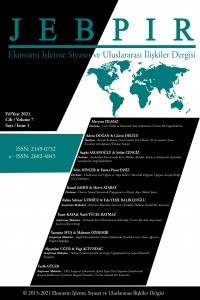OECD Ülkeleri ile Yükselen Piyasalarda Finansal Gelişme ve Faiz Oranlarının, Ekonomik Büyüme Üzerindeki Etkisi
Bu çalışmanın temel amacı bir finansal gelişme ölçütü olan finansal kesim içerisindeki tasarruflar ile ekonomik büyüme arasındaki ilişkiyi farklı ülke gurupları için araştırmaktır. Bunun yanında faiz oranları ve ekonomik büyüme arasındaki etkileşim de incelenecektir. Söz konusu ilişkilerin incelenmesi amacı ile Granger nedensellik analizi OECD ülkeleri ve yükselen piyasalar için kullanılmıştır. Finansal gelişme ölçütü olarak ele alınan, tasarruf ile ekonomik büyüme arasında bu iki ülke grubu için test sonuçlarına göre bir ilişkinin olmadığı görülmüştür. Diğer taraftan iki ülke grubu için faiz oranlarında görülen değişimlerin de tasarrufları artırıcı yada azaltıcı herhangi bir etkiye sahip olmadığı anlaşılmıştır. Faizlerde görülen değişimler, gelişmiş ekonomiler olan OECD ülkeleri ile yükselen piyasalar için ekonomik büyüme açısından farklı sonuçlara neden olduğu izlenmiştir. Yükselen piyasalarda faiz oranları ile ekonomik büyüme arasında negatif yönlü bir ilişki varken OECD ülkelerinde bu ilişki pozitif yönlüdür.
Anahtar Kelimeler:
Ekonomik Büyüme, Finansal Gelişme, Tasarruf, Faiz, Granger Nedensellik
___
- Abu-Bader, Suleiman ve Aamer S. Abu-Qarn (2008), “Financial Development and Economic Growth: Empirical Evidence from Six MENA Countries”. Review of Development Economics. Vol.12(4), ss.803–817.
- Akimov, A., Wijeweera, A. ve Dollery, B. (2009) “Financial Development and Economic Growth: Evidence from Transition Economies” Applied Financial Economics, 19(12):999-1008.
- Al-Yousif, Yousif Khalifa (2002), “Financial development and economic growth: Another look at the evidence from developing countries”, Review of FinancialEconomics, c.11. ss.131-150.
- Arestis, P.; Demetriades, P. ve Luintel, K. B. (2001) “Financial Development and Economic Growth: The Role of Stock Markets. Journal of Money”, Credit and Banking, 33(1), 16–41.
- Arestis, Philip ve Panicos Demetriades (1997), “Financial development and economic growth: Assesing the evidence”, Economic Journal, c.107. S.442. ss.783-799.
- Atindehou, R.B., Gueyie, J.P., & Amenounve, E. K. (2005).Financial intermediation andeconomic growth: evidence from Western Africa, Applied Financial Economics, 15(11), 777 – 790.
- Breitung, J. (2000). Thelocalpower of someunitroottests for panel data. Advances in Econometrics, Volume 15: NonstationaryPanels, Panel Cointegration, andDynamicPanels, ed. B. H. Baltagi, 161–178. Amsterdam: JAY Press.
- Breitung, J.,and S. Das. (2005).Panel unitroottestsundercross-sectional dependence. StatisticaNeerlandica 59: 414–433.
- Choi, I. (2001).Unitroottestsfor panel data. Journal of International Money and Finance 20: 249–272.
- De la Torre, A., Gozzi, J.C. ve Schmukler, S.L. (2006). Innovative Experiences in Access to Finance: Market Friendly Roles for the Visible Hand? Latin America Regional Studies Series, World Bank.
- Demetriades, Panicos O. ve Khaled A. Hussein (1996), “Does financial development cause economic growth? Time-series evidence from 16 countries”, Journal of Development Economics, c.51. ss.387-411.
- Fase, M.M.G., R.C.N. Abma (2003) “Financial Environment and Economic Growth inSelected Asian Countries”, Journal of Asian Economics, 14(1), 11-21.
- Ghirmay, T. (2004). Financial Development and Economic Growth in Sub-Saharan African Countries: Evidence from Time Series Analysis. African Development Review, 16(3), 415–432.
- Gregorio, Jose De ve Pablo E. Guidotti (1995), “Financial development and economic growth”, World Development, c.23. S.3. ss.433-448. Hadri, K. 2000.Testingforstationarity in heterogeneous panel data. EconometricsJournal 3: 148–161.
- Harris, R. D. F.,and E. Tzavalis. 1999.Inferenceforunitroots in dynamicpanelswherethe time dimension is fixed. Journal of Econometrics 91: 201–226.
- Hassan, M.K., Sanchez, B. ve Yu, J. (2011) “Financial Development and Economic Growth: New Evidence from Panel Data” The Quarterly Review of Economics and Finance, 51(1):88-104. Im, K. S., M. H. Pesaran, and Y. Shin. 2003.Testingforunitroots in heterogeneouspanels. Journal of Econometrics 115: 53–74.
- Jung, Woo S. (1986), “Financial development and economic growth: International evidence”, Economic Development and Cultural Change, c.34. ss.333-346.
- Kar, M., Nazlıoğlu, Ş. ve Ağır, H. (2011) “Financial Development and Economic Growth Nexus in the MENA Countries: Bootstrap Panel Granger Causality Analysis”, Economic Modelling, 28, 685-693.
- King, R.G. ve Levine, R., (1993), “Finance and Growth: Schumpeter Might be Right”, Quarterly Journal of Economics, 108(3), 717–737.
- King, Robert G. ve Ross Levine (1993), “Finance and growth: Schumpeter might be right”, Quarterly Journal of Economics, c.108. S.3. ss.717-737.
- Levin, A., C.-F. Lin, and C.-S. J. Chu. (2002).Unitroottests in panel data: Asymptoticandfinite-sampleproperties. Journal of Econometrics 108: 1–24.
- Levine, Ross E. ve Sara Z. (1996), “Stock market development and long-run growth”, World Bank Policy Research Working Paper, No: 1582.
- Lynch, D. (1996) “Measuring Financial Sector Development”, Journal of Monetory Economics, 22, ss.3-42.
- Lynch, D. (1996), “Measuring Financial Sector Development: A Study of Selected Asia-Pacific Countries”, The Developing Economies, 34(1), 1-27.
- McKinnon, R.I. (1973). Money and Capital in Economic Development. Washington. DC: The Brookings Instution.
- Mhadhbi, Khalil (2014), “Financial Development and Economic Growth: A Dynamic Panel Data Analysis”, International Journal of Econometrics and Financial Management, 2(2), 48-58.
- Shan, Jordan ve Alan Morris (2002), “Does financial development ‘lead’ economic growth?”, International Review of Applied Economics, c.16. S.2. ss.153-168.
- Shan, Jordan Z., Alan G. Morris ve Fiona Sun (2001), “Financial development and economic growth: An egg-and-chicken problem?”, Review of International Economics, c.9. S.3. ss.443-454.
- Shaw, E.S. (1973). Financial Deeping in Economic Development. Newyork: Oxford University Press
- TCMB., 2013 Bülten, Sayı 31, Eylül 2013
- ISSN: 2149-0732
- Yayın Aralığı: Yılda 2 Sayı
- Başlangıç: 2015
- Yayıncı: Kırıkkale Üniversitesi
Sayıdaki Diğer Makaleler
AHMET ÖZSOY: 28 ŞUBAT’TAN 15 TEMMUZ’A
Trafficking in Human Beings in Global Age: A Case Study of Turkey
Murat GÜL, Tuğba SARIKAYA GÜLER
Türkiye İçin İşsizlik Oranının Bağımsızlığı Hipotezi Testi
“The Other” in the Roots of Marxist Philosophy
Ahmet Özsoy: Direnen Halk "Darbe"si Şehidi
İdarenin Sorumluluğu Ve Danıştay Kararlarındaki Görünümüne Genel Bakış
